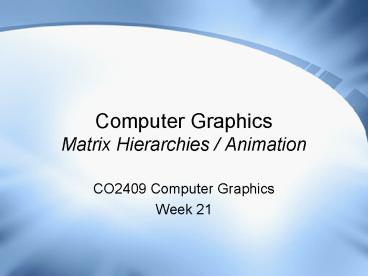Computer Graphics Matrix Hierarchies Animation - PowerPoint PPT Presentation
1 / 15
Title:
Computer Graphics Matrix Hierarchies Animation
Description:
However, now we will focus on manipulating (animating) geometry that is: ... Two people carrying a stretcher. Need more complex solution for these cases ... – PowerPoint PPT presentation
Number of Views:186
Avg rating:3.0/5.0
Title: Computer Graphics Matrix Hierarchies Animation
1
Computer GraphicsMatrix Hierarchies / Animation
- CO2409 Computer Graphics
- Week 21
2
Lecture Contents
- Model Animation
- Model/Matrix Hierarchies
- Limitations of Hierarchies
- Rendering a Model Hierarchy
- Matrix Stacks
- Process
3
Model Animation
- So far we have looked at individual models
- Each a fixed piece of geometry
- No moving parts
- We have animated these models
- By moving and rotating them each frame
- However, now we will focus on manipulating
(animating) geometry that is - Made of several rigid parts or
- Flexible with an underlying skeleton
4
Rigid Body Animation
- We start with models made up of several rigid
parts that can move with respect to each other - Mainly mechanical models, such as vehicles,
doors, guns, robots etc. - A common assumption for such models is that the
parts form a hierarchy - A tree structure defining how the parts are
connected
5
Matrix Hierarchies
- In such a hierarchy
- Each part has a parent (or is the root of the
tree) - A part can have any number of children (including
0) - Each part in the hierarchy has a world matrix
- Defining its position and orientation - just like
a model - But the world matrix for each part is stored
relative to its parent
- So each part is defined in the local space of its
parent - Root is stored in world space
- Implies that child parts inherit their parents
movement
6
Matrix Hierarchy Diagram
- Such hierarchies are sometimes called Matrix
Hierarchies or Transform Hierarchies
7
Building Hierarchies
- The position of a childs origin determines where
it will pivot relative to its parent - The orientation of its axes will determines how
it will rotate (in X, Y and Z) - So the parts matrix defines the joint with its
parent
- Must ensure that we (or the artists) build the
hierarchies and part matrices correctly - To allow required animation
8
Limitations of Hierarchies
- Most multi-part objects fit naturally into a
hierarchical form, but not all - A bicycle chain which link is the root?
- Also assumes each part has only one parent that
controls its movement - Not true when multiple forces involved
- Train carriage with two engines
- Two people carrying a stretcher
- Need more complex solution for these cases
- Use soft body methods or physics engine
9
Rendering Hierarchies
- Need to render a hierarchy of model parts
- Each with its own parent-relative world matrix
- Can simply make the existing rendering code
recursive the code for each part is - Get world matrix by combining this parts matrix
with the parents world matrix - Render part with combined matrix
- Repeat process for each child part
- This process dictates a depth-first traversal of
the hierarchy tree structure - To pass matrices from parent to child easily (see
lab)
10
Rendering Hierarchies Matrix Stack
- Recursion is inefficient for a real-world app
that has many models with many parts - We can convert this recursive process into an
iterative process - To help us we use a Matrix Stack
- To store the matrices for ancestors of the
current part - DirectX provides such a feature
- Not difficult to write our own if necessary
- This is an efficient LIFO structure for pushing
and popping matrices
11
Rendering Hierarchies Efficiently
- Put parts into a list in depth-first order
- Done in advance
- Also store depth in the hierarchy of each part
- Each part has its parent-relative world matrix
- Call it the local matrix
- In the example will use L0, L1 etc.
12
Rendering Hierarchies Efficiently
- Iterating through the list is now the same as
traversing the tree depth-first - At each step, will keep track of
- Absolute world matrix call it W
- Current depth in hierarchy call it CurrentDepth
- Initialise the process
- Set W the identity / unit matrix
- Set CurrentDepth 0
- Start with empty matrix stack
13
Rendering Hierarchies cont
- For each part x in the hierarchy list
- Get depth of part x, call it NewDepth
- If NewDepth gt CurrentDepth, push W onto stack
- If NewDepth CurrentDepth, do nothing to stack
- If NewDepth lt CurrentDepth, pop matrices from
stack - Pop (CurrentDepth NewDepth) times
- E.g. CurrentDepth 3, NewDepth 1, pop stack
twice - Set W Matrix at top of stack Lx
- Render part x using world matrix W
- CurrentDepth NewDepth
14
Rendering Hierarchies Example
- Starting with W identity(I) CurrentDepth 0
- 0. NewDepth 1 gt CurrentDepth push W
(StackI) - W Stack Top L0 L0 render base with
world matrix L0 - 1. NewDepth 2 gt current push W (StackI,L0)
- W Stack Top L1 L0.L1 render arm
with matrix L0.L1 - 2. NewDepth 3 gt current push W
(StackI,L0,L0.L1) - W Stack Top L2 L0.L1.L2 render grip1
with matrix L0.L1.L2 - 3. NewDepth 3 current no change
(StackI,L0,L0.L1) - W Stack Top L3 L0.L1.L3 render grip2
with matrix L0.L1.L3 - 4. NewDepth 2 lt current pop stack 1 time
(StackI,L0) - W Stack Top L4 L0.L4 render switch
with matrix L0.L4
15
Rendering Hierarchies Example
- Looking just at the render steps
- Render base with world matrix L0
- Render arm with matrix L0.L1
- Render grip1 with matrix L0.L1.L2
- Render grip2 with matrix L0.L1.L3
- Render switch with matrix L0.L4
- These are the correct combined matrices































